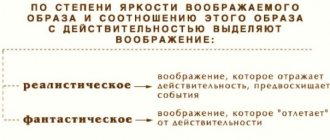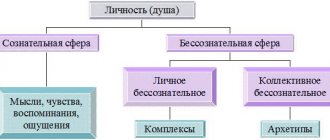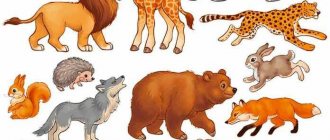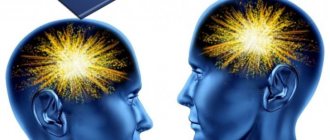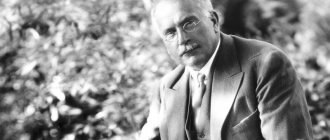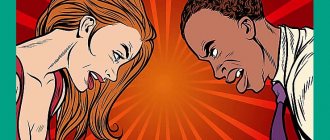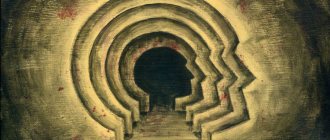The quintessence of the theory of psychological types by C. G. Jung
During his medical practice, Carl Jung noticed that patients differed not only in many individual psychological characteristics, but also in typical traits. As a result of the study, scientists identified two main types: extroverted and introverted. This division is due to the fact that in the process of life of some people their attention and interest were directed to a greater extent to an external object, outside, while for others - to their inner life, that is, the subject was a priority.
However, Jung warned that it is almost impossible to meet one or the second type in its pure form, since this can be a great hindrance for social adaptation. This gives rise to the idea of the existence of mixed types that arise as a result of compensation for the one-sidedness of one personality type, but with a predominance of extraversion or introversion. As a result of this compensation, secondary characters and types appear, which complicate the definition of a person as extroverted or introverted. Even more confusing is the individual psychological reaction. Therefore, in order to more accurately determine the predominant extraversion or introversion, extreme care and consistency must be observed.
Jung emphasizes that the division of people into two main psychological types was made long ago “by experts on human nature and reflected by deep thinkers, in particular Goethe,” and has become a generally accepted fact. But different outstanding personalities described this division in different ways, based on their own feelings. Regardless of the individual interpretation, one thing remained common: there were those whose attention was directed and dependent on the object, turning away from the subject, that is, themselves, and those whose attention was rejected from the object and directed to the subject, his mental processes, that is turned to his inner world.
K. G. Jung notes that each person is characterized by both of these mechanisms, with one or the other being more pronounced. Their integration is a natural rhythm of life, similar to the function of breathing. And yet, the difficult circumstances in which most people find themselves, both the external social environment and internal discord, rarely allow these two types to coexist harmoniously within a person. Therefore, there is an advantage either in one direction or the other. And when one or the other mechanism begins to dominate, the formation of an extroverted or introverted type occurs.
After a general introduction, Jung conducts research into the history of the identification of mental types, starting from ancient times and ending with his own detailed description of the extroverted and introverted types. In the first chapter, Jung analyzes the problem of mental types in ancient and medieval thought. In the first section of this chapter, he draws a comparison between the ancient Gnostics and the early Christians Tertullian and Origen, to show that one was an introverted personality and the other an extroverted one. Jung notes that the Gnostics proposed a division of people into three types of character, where in the first case thinking (pneumatic) predominated, in the second - feeling (psychic), in the third - sensation (gilik).
Revealing Tertullian's personality type, Jung points out that in his commitment to Christianity he sacrificed what was his most valuable asset - his highly developed intellect, his desire for knowledge; in order to concentrate completely on the inner religious feeling, on his soul, he rejected his mind. Origen, on the contrary, having introduced Gnosticism into Christianity in a mild form, strove for external knowledge, for science, and in order to free the intellect on this path, he committed self-castration, thereby removing the obstacle in the form of sensuality. Jung sums it up by arguing that Tertullian was a clear example of an introvert, and a conscious one, because in order to focus on the spiritual life, he abandoned his brilliant mind. Origen, in order to devote himself to science and the development of his intellect, sacrificed what was most expressed in him - his sensuality, that is, he was an extrovert, his attention was directed outward, to knowledge.
In the second section of the first chapter, Jung examines theological controversies in the early Christian church to show, through the example of the confrontation between the Ebionites, who argued that the Son of Man had a human nature, and the Docetes, who defended the point of view that the Son of God only had the appearance of flesh, the one belonging to extroverts, the second - to introverts, in the context of their worldview. The intensity of these disputes led to the fact that the former began to put human sensory perception directed outward at the forefront, while the latter began to consider the abstract, extraterrestrial as the main value.
In the third section of the first chapter, Jung examines psychotypes in the light of the problem of transubstantiation, relevant for the mid-9th century AD. Again he takes two opposing sides for analysis: one - in the person of Paschasius Radbert, the abbot of the monastery, who argued that during the rite of communion, wine and bread turn into the flesh and blood of the Son of Man, the second - in the person of the great thinker - Scotus Erigena, who did not want to accept the general opinion, defending its point of view, “fabrications” of its cold mind. Without diminishing the significance of this sacred Christian ritual, he argued that communion is a memory of the last supper. Radbert's statement received universal recognition and brought him popularity, since he, without having a deep mind, was able to sense the trends of his surroundings and give the great Christian symbol a rough sensual coloring, so Jung points us to clearly defined features of extraversion in his behavior. Scotus Erigena, possessing an extraordinary mind, which he was able to show by defending a point of view based only on personal conviction, on the contrary, met a storm of indignation; unable to empathize with the trends of his environment, he was killed by the monks of the monastery in which he lived. C. G. Jung classifies him as an introverted type.
In the fourth section of the first chapter, Jung, continuing the study of extroverted and introverted types, compares two opposing camps: nominalism (prominent representatives are Atysthenes and Diogenes) and realism (leader - Plato). The beliefs of the former were based on the attribution of universals (generic concepts), such as goodness, man, beauty, etc. to ordinary words that have nothing behind them, that is, they were nominalized. And the latter, on the contrary, gave each word spirituality, a separate existence, affirming the abstractness and reality of the idea.
In the fifth section of the first chapter, developing his thought, Jung examines the religious dispute between Luther and Zwingli about the sacrament, noting the contrast of their judgments: for Luther, the sensory perception of the rite was important, for Zwingli, the spirituality and symbolism of the sacrament had priority.
In the second chapter of “Schiller's Ideas on the Problem of Types,” C. G. Jung relies on the work of F. Schiller, whom he considers one of the first to analyze these two types, connecting them with the concepts of “sensation” and “thinking.” Noting, however, that this analysis bears the imprint of Schiller’s own introverted type. Jung contrasts Schiller's introversion with Goethe's extroversion. At the same time, Jung reflects on the possibility of an introverted and extroverted interpretation of the meaning of the universal “culture”. The scientist analyzes Schiller’s article “On the Aesthetic Education of Man,” polemicizing with the author, discovering the origins of his intellectual constructions in his feelings, describing the struggle of the poet and thinker in him. Jung is attracted to Schiller's work primarily as a philosophical and psychological reflection that poses questions and problems of a psychological nature, albeit in Schiller's terminology. Of great importance for understanding Jung's theory are his discussions of Schiller's symbol as a middle state, a compromise between opposing conscious and unconscious motives.
Next, Jung examines Schiller's division of poets into naive and sentimental and comes to the conclusion that we have before us a classification based on the creative characteristics of poets and the characteristics of their works, which cannot be projected onto the doctrine of personality types. Jung dwells on naive and sentimental poetry as examples of the operation of typical mechanisms and the specificity of the relationship to an object. Since Schiller moves from typical mechanisms directly to mental types, similar to Jung’s types, the scientist states that Schiller identified two types that have all the signs of extrovert and introvert.
Continuing his research, in the third chapter, C. G. Jung examines the work of the German philosopher Friedrich Nietzsche in the light of the latter’s vision of the division into psychotypes. And if Schiller called his pair of typical opposites idealistic-realistic, then Nietzsche calls it Apollonian-Dionysian. The term - Dionysian - owes its origin to Dionysus - a character in ancient Greek mythology, half god, half goat. Nietzsche's description of this Dionysian type coincides with the characterological features of this character.
Thus, the name “Dionysian” symbolizes the freedom of unlimited animal drive, the collective comes to the fore, the individual comes to the background, the creative power of the libido, expressed in the form of drive, captures the individual as an object and uses him as an instrument or expression. The term “Apollonian” comes from the name of the ancient Greek god of light Apollo and conveys, in Nietzsche’s interpretation, a sense of internal silhouettes of beauty, measure and feelings, subject to the laws of proportions. Identification with a dream clearly focuses on the property of the Apollonian state: this is a state of introspection, a state of observation directed inward, a state of introversion.
Nietzsche's consideration of types is on an aesthetic plane, and Jung calls this a “partial consideration” of the problem. However, according to Jung, Nietzsche, like no one before him, came closer to understanding the unconscious mechanisms of the psyche, the motives underlying the opposing principles.
Further, in the fourth chapter, “The Problem of Types in Human Science,” Jung studies Furneaux Jordan’s work “Character from the Point of View of the Body and Human Genealogy,” in which the author examines in detail the psychotypes of introverts and extroverts, using his own terminology. Jung criticizes Jordan's position in using activity as the main criterion for distinguishing types.
The fifth chapter is devoted to the problem of types in poetry. Based on the images of Prometheus and Epimetheus in the poetry of Karl Spitteler, the scientist notes that the conflict of these two heroes expresses, first of all, the opposition between introverted and extroverted development options in the same personality; however, the poetic creation embodies these two directions in two separate figures and their typical destinies. Jung compares the images of Prometheus in Goethe and Spitteler. Reflecting in this chapter on the meaning of the unifying symbol, Jung notes that poets are able to “read into the collective unconscious.” In addition to his contemporary cultural interpretation of the symbol and spirit of opposites, Jung dwells on both the ancient Chinese and Brahmanistic understanding of opposites and the unifying symbol.
Next, Jung examines psychotypes from the perspective of psychopathology (sixth chapter). For research, he chooses the work of psychiatrist Otto Gross, “Secondary Cerebral Function.” K. G. Jung notes that in the presence of mental disorders, it is much easier to identify a psychotype, because they are a magnifying glass in this process.
The scientist then turns to aesthetics (chapter seven). Here he relies on the works of Worringer, who introduces the terms “empathy” and “abstraction”, which perfectly characterize the extroverted and introverted type. Empathy feels the object to a certain extent empty and for this reason can fill it with its life. On the contrary, abstraction sees the object as alive and functioning to a certain extent, and because of this it tries to avoid its influence.
In the eighth chapter of his work, Jung moves on to consider psychotypes from the point of view of modern philosophy. For the study, he chooses the position of the representative of pragmatic philosophy, William James. He divides all philosophers into two types: rationalists and empiricists. In his opinion, a rationalist is a sensitive person, an empiricist is a ossified person. If free will is important to the first, then the second is subject to fatalism. By asserting something, a rationalist, unnoticed by himself, plunges into dogmatism; an empiricist, on the contrary, adheres to skeptical views.
In the ninth chapter, Jung turns to the science of biography, in particular the work of the German scientist Wilhelm Ostwald. Compiling biographies of scientists, Ostwald discovers the contrast between types, and gives them the name classical type and romantic type. The first type indicated tries to improve his work as much as possible, therefore he works slowly, he does not have a significant impact on the environment, because he is afraid of making a mistake in front of the public. The second type - classical - exhibits absolutely opposite properties. It is characteristic of him that his activities are varied and numerous, the result of which is a large number of successive works, and he has a significant and strong influence on his fellow tribesmen. Ostwald notes that it is precisely the high speed of mental reaction that is a sign of a romantic and distinguishes him from a slow classic.
And finally, in the tenth chapter of this work, C. G. Jung gives his “general description of types.” Jung describes each type in a certain strict sequence. First, in the context of the general attitude of consciousness, then, in the context of the attitude of the unconscious, then - taking into account the characteristics of basic psychological functions, such as thinking, feelings, sensations, intuition. And on this basis, he also identifies eight subtypes. Four for each main type. Thinking and feeling subtypes, according to Jung, belong to the rational, sensing and intuitive - to the irrational, regardless of whether we are talking about an extrovert or an introvert.
The best books by Carl Jung
Jung's work is extensive and draws much material from his own autobiography, including books, essays and personal reflections. We can even find correspondence between Jung and Freud from 1906-1913. These letters delve into the development of the psychoanalytic movement and the relationship between these two figures.
Now, in this article about the best books of Carl Jung, our priority is to quote his most representative work. We are looking for books that will delight everyone, from beginners to seasoned Jungians, with their concepts, theories and ideas.
Practical application of the concept of psychotypes by C. Jung today
Today, it will not be difficult for a psychologist to determine the basic personality type. The main use of this work by Jung is career guidance. After all, if a person is withdrawn and does everything slowly, for example, as a salesperson in a high-traffic sales area, as in general, it is better not to work as a salesperson. Since this profession involves a large number of contacts during the day, and not always comfortable ones, which can greatly undermine the psychological health of an introvert. And the effectiveness of such activities will be low. If, on the contrary, a person belongs to the basic extroverted type, he can safely choose activities associated with a large number of personal contacts, including as a leader - manager or director.
This theory is also used in family psychology. Moreover, at the stage of family planning. Since, if a couple, say, consists of a typical extrovert or a typical introvert, the life of such a marriage will be short-lived. After all, if the wife has a desire to focus on her husband, limiting his non-work communication, being the most introverted person, and the husband, on the contrary, being a typical extrovert, has a need for a large number of guests in their home or a desire to often be in the company of friends, this can serve the cause of discord, and possibly divorce. But, since psychotypes with the most prevalent one typical attitude are quite rare, it is possible to choose a partner who, even being an extrovert, will be able to pay enough attention to his life partner and have a not particularly pronounced need for frequent friendly contacts.
Literature:
- Jung K. G. Psychological types. M., 1998.
- Babosov E.M. Carl Gustav Jung. Minsk, 2009.
- Leibin V. Analytical psychology and psychotherapy. St. Petersburg, 2001.
- Khnykina A. Why is Jung so brilliant? 5 main discoveries of a psychiatrist // Arguments and facts - 07/26/15.
Author: Elena Andreeva psychologist
- To write or not to write? - that is the question https://psychosearch.ru/7reasonstowrite
- How to become a partner of PsychoPoisk magazine? https://psychosearch.ru/onas
- Several ways to support PsychoSearch https://psychosearch.ru/donate
| If you notice an error or typo in the text, highlight it with the cursor and press Ctrl + Enter | Didn't like the article? Write to us why, and we will try to make our materials better! |
Book No. 3. Relationship between ego and unconscious
As we already know, Carl Jung was the founder of the school of analytical psychology. This book is without a doubt the best presentation of this approach. It is also, in fact, a reflection of a small part of the history of psychology.
In these pages, Jung takes us through a much more original idea than Freud was offering us at the time concerning the human psyche . His constant research and revision of the subject gives us a more complete understanding of the unconscious. Here Jung establishes a duality between the collective unconscious and its influence on the individual unconscious.
Book No. 7. Psychology of transference
This is one of Carl Jung's most representative books on this topic. He also draws an interesting parallel between alchemy and transference between patient and therapist . As we already know, in everyday practice psychotherapy can cause a phenomenon in which the patient ends up projecting his experiences and emotions onto the therapist, which complicates the recovery process.
In this book, Jung again uses his symbolic figures to explain the dynamics and connections that sometimes arise between doctor and patient.
Book number 10. Memories, dreams, reflections
In these pages we learn about his formative years, his tense but productive relationship with Freud, and how each trip, conversation, discovery and experience shaped what he calls “the bottom of his soul.”
It is worth noting that the reader will not see a simple book of memories and personal reflections about someone in the twilight of his life. Jung takes full advantage of the opportunity to re-establish the foundations of his theories. He describes his ideas about the human mind, the unconscious, the role of symbolism and the principles of psychotherapy.
This book will help you better understand the thoughts of Carl Jung and his personal work as a psychologist.
Individuation
Another fundamental concept in Jung’s concept was individuation, the implementation of which was seen by the scientist as the goal of all psychotherapy.
Individuation is a process in which human consciousness suddenly feels its separate position, its separation from nature. The easiest way to explain this concept is to use the example of a child. At a certain stage of his development, up to a certain point in his life, the baby does not distinguish himself from the world around him, in connection with this, for example, he can talk about himself in the third person (“Masha is in pain, she hit herself”). Then the world around him for the child is himself. But then there comes a time when the little person suddenly begins to realize and feel disconnected, a loss of connection with the world, which he had not felt before, but was necessary for him. Suddenly he realizes that he is no longer a part of nature, so he experiences incredible fear and a desire to merge with it again, to return everything. But now this is becoming impossible.
Man nevertheless needs this fusion with nature. Jung said that this is why people create magic, rituals, and various kinds of myths, with the help of which they return to this bosom of nature for a second and feel the relationship with it and their integrity. Over time, rituals become more complex, branched, differentiated, and acquire increasingly vivid intellectual, emotional, volitional, and psychological coloring. And so, according to Jung, religion appears, the most important role of which is to maintain a sense of integrity in a person.
Book number 6. Conflicts of a child's soul
Some of our readers may be surprised to see the term "soul" in a book about psychology. It is important to remember that in the work of Carl Jung this idea, this concept is always present.
As Jung explained in his autobiography, no doctor could cure a patient without making contact with the patient's soul.
This idea gives us the key to Jung's holistic approach to people. He believed that childhood and adolescence are the most important stages of a person's life, so we should pay much more attention to them. Thus, the possible conflicts, shortcomings and prejudices that the child experiences in his family, as well as the personality of the parents, undoubtedly determine the well-being or potential psychological problems of the child in later life.
It is curious that Sigmund Freud's daughter dedicated her life to this goal. She provided psychological assistance to children with childhood trauma . Freud himself never paid much attention to this area and did not fully develop it in his work.
